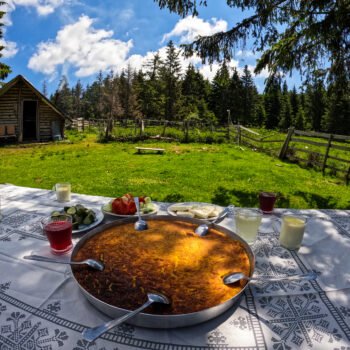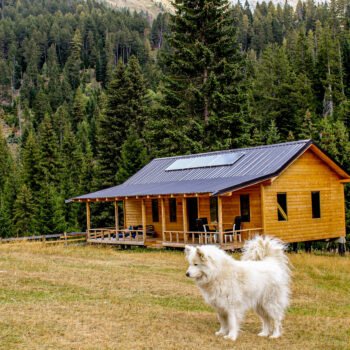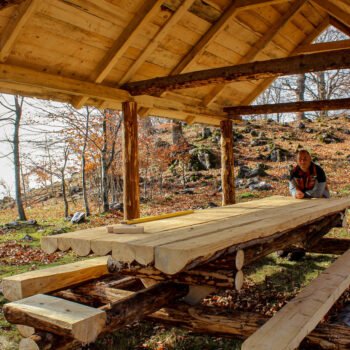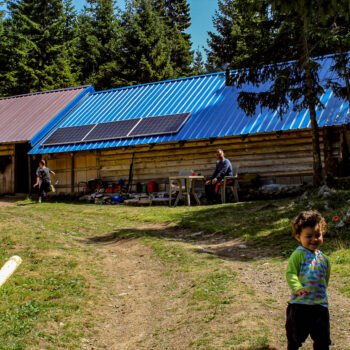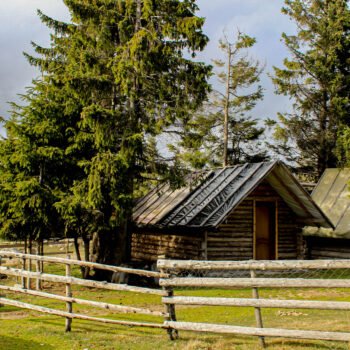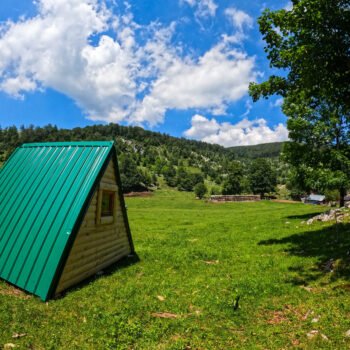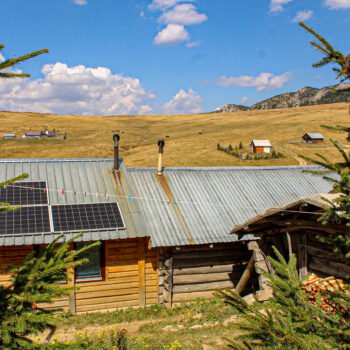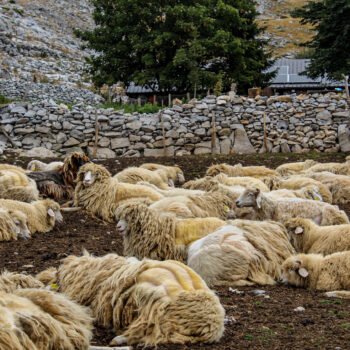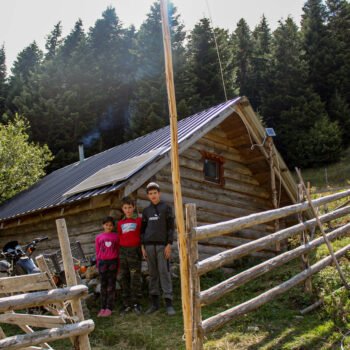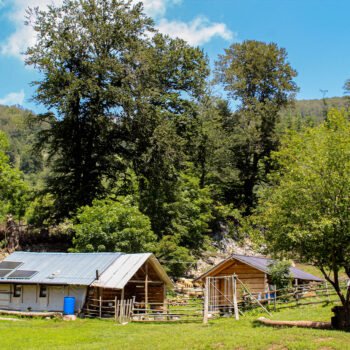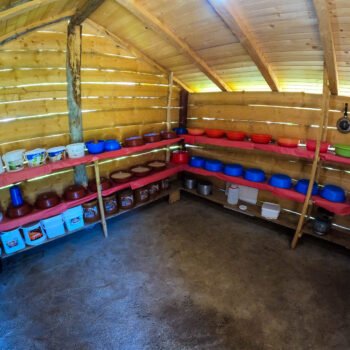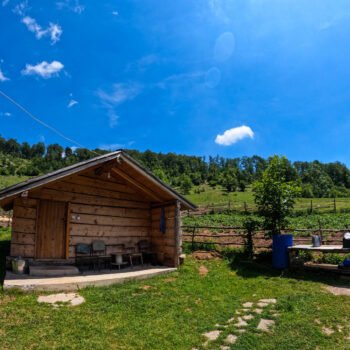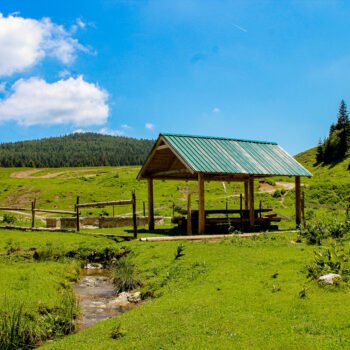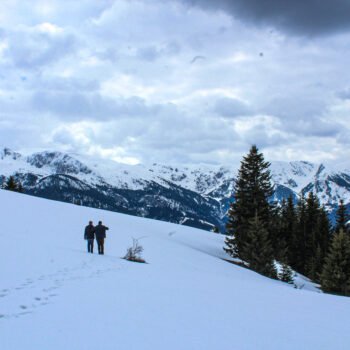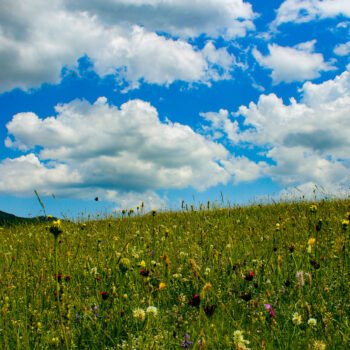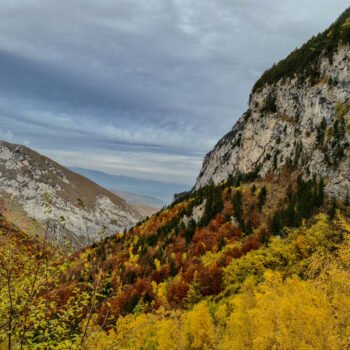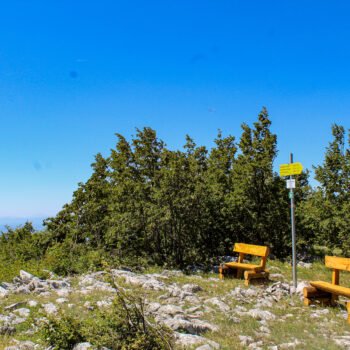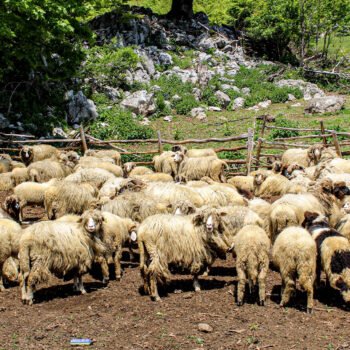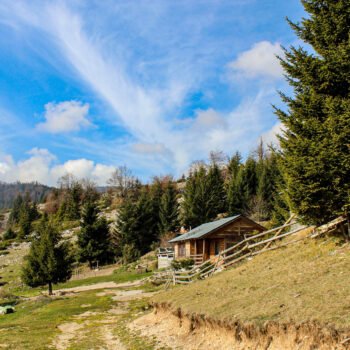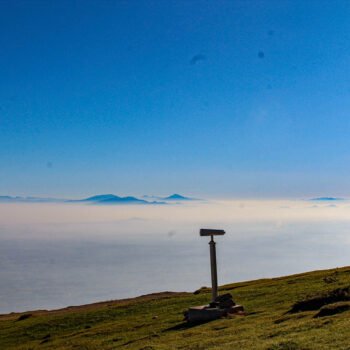Katun Road Istog
At the entrance of the city, we are greeted with a sign that welcomes us “Welcome to Istog”. Istog is one of the constituent municipalities of Kosovo, which is located near the city of Peja in the western part of Kosovo.
After passing the urban part of the city, which is not of interest to us in this brochure, only a few kilometers away we see green hills, villages and roads that lead to the magic of Istog’s mountains.
Few of us know that this territory consisting of an area of 453.84 km2, in terms of geography and ethno-culture, is also known as Podgur, which is an ethnographic sub-province that occupies the northern position of the Dukagjin Plain. The geographic limitation of Podgur begins with the source of the “Drini i Bardhë” river, climbs to the top of Rusolia, continues with the massif of the Mokna mountains, while the eastern and southeastern border is the “Gujavç” river. The meeting of the river “Gujavç”, with the river “Istogu” and with the “Drin e Bardhë” geographically completes the Podguri region. The first people of this region have named as “Floor of stone” the rock which forces the three water sources “Istog”, “Vrella” and “Drin e Bardhë” to erupt at the same altitude. The “hills of Istog” are known for their beautiful landscapes, which are used for cattle pastures and breeding grounds for livestock farmers. The most popular landscapes are: “White Stones”, “Meadows of Istog”, “Bollovani”, “Bajshja”, “Radusha”, “Vuqa”, “Rudina”, “Kosharishta”, “Vojdulla”, “Mokna”, “Shymeku”, “Cerrovoda”, “Lugu i Butë”, “Lugu i Zajmi”, “Koreniku”, “Lugu i Madh”, “Kodra e Dynes”, “Gurra”, “Klopqani”.
While further to the west is the city of Peja and it has a very suitable place in the Dukagjin Plain. With the rapid flow of the rocky canyon of Rugova, the river Lumbardhi of Peja begins to flow through the plain of Peja, passing through the city and dividing it into two parts. Lumbardhi, which during its course forms fertile fields, flows into the largest river called Drini i Bardhë, which originates from the Zhlebi river in the village of Radavc. Drini i Bardhë runs through the entire western side of the Dukagjin Plain and joins the Black Drini that comes from Dibra to Kukësi and forms the Drini River that flows into the Adriatic Sea.
BACKGROUND
The district of Istog lies at the top of northern Dukagjin, on the edge of Bjeshka e Thate and Mountain of Mokna. In the north it is bordered by Serbia and in the north-west by Montenegro, and in the east it is bordered by the District of Skënderaj, Drenica, in the south by the Drin River and in the south-west by the District of Peja. It is a very fertile region, crossed by two rivers, the largest and longest Albanian river, the Drini i Bardhë, which also originates in these parts, and the Istog River.
Meanwhile, the city of Peja is surrounded by the Accursed Mountains, which are part of the Dinaric massif and which include the entire western Balkans. These peaks form a crown of high peaks such as: Kopranik Peak, Lumbardhi Mountains, which include Guri i verdhë, Vjedullak Peak, Hajla, Hasan Peak and others.
CLIMATE
Recent climate changes have also affected our country. Now we have shorter winters and hotter and longer summers. However, this side is characterized by a mild continental climate, mainly as a result of the proximity of the mountain crown of Mokna Mountain from the northern part, which has a great influence on the frequent temperature changes. This area does not differ much from the other territories of the northern part of the Dukagjin Plain, which are largely under the influence of the continental climate and which have less heat and more precipitation. However, as a result of the fields which lie at the lowest quotas of altitude in Kosovo, only close to 350-400 meters, where the air flow is created between them with the ridges of the high mountains of Mokna, which has conditioned since Istog blow the strongest north wind in the Balkans. The characteristic of this strong wind is that it blows only along the foothills and does not penetrate more than ten kilometers deep into the field. They blow along all the mountains, from Runik and Radavci, and the strongest is in Istog and its nearest villages.
However, average temperatures in January are around -0.5°C, while the highest in August are around 23-24°C.
FLORA AND FAUNA
In this region, Accursed Mountains and Mokna Mountain, there are more than 797 types of different plants, such as different types of medical plants known by popular names among the population: Cowslip, Coltsfoot, Hawthorn, Broadleaf Plantain, Yarrow, Breckland thyme, Oregano, Mint, Blueberry, Common juniper, Nettle, Lemon balm, Rue, the great yellow gentian, Shushorka, Mugworts, Raspberry, Strawberry, Chamomile, Hollyhock, Rodhezja, Qakorrja, Camphor, Vreza, Kinfusha, Sage, Juniper, Gram, Prostrate knotweed, Dog Rose, Wild Apple, Elder, Lena, Valerian, Bear’s Bread, etc. This area is also rich with a variety of medical plants, but due to lack of maintenance and conservation, these plants and animals are the endangered part of the biodiversity.
The bear, wolf, pig, roe deer, goat, rabbit, fox, jackal, guitar, jackal, bukla, chicken, cow, flanxa, eagle, cuckoo, woodpecker, nightingale are some of the animals that can be found in this region. However, several types of poisonous snakes grow in “Mountains of Istog”, such as: rattlesnake, ball snake, then non-poisonous, such as breve and boll.
In addition to them, several types of fish grow in the waters of the Istog river, such as bream, eel, trout, brook trout, catfish, bream, bream and Danube trout.
LINKING TRADITIONS WITH MODERNITY
Local residents have ensured the set up of katuns (huts) in their mountains of origin. Those katuns, in addition to serving them as shelter while keeping the cattle during the summer, they have recently, with the development of mountain tourism, also served as a resting point for local and international tourists. Now, the continuous construction of the katuns, which are also being used as inns, has not spoiled the nature, on the contrary, it has made it even warmer and more attractive for many climbers and foreign tourists.
Some of these guesthouses or katuns continue to be inhabited even by their owners during the summer season, who decide to disconnect from the noisy streets, and polluted air, to hide among the chirping of birds and the fresh air up in the mountains. In order to contribute even more to the development of this tourism, the Initiative for Agriculture Development of Kosovo – IADK has been supporting mountain katuns with solar energy equipment for some time. Spending your vacation in one of these katuns which are located in the mountains of Istog and Peja and which are part of the “Trashumance – new tourism offer of Kosovo and Montenegro” project, in addition to creating a distance away from any noise of everyday life in urban areas, they also create a distance from anything electrical.
There are dozens of such guesthouses which keep their doors open to accommodate those who wish to spend the night in the beautiful mountains of Istog and Peja. Those katuns can be found in Mokna, Jerebi, Bajshe, Cerrovoda, Lugu i Bute, Shoshan, Hakanishe, Bjeshket e Thata, Sejnovo, Rusoli, Shtedim and others. This can be described simply, however, the feeling in these katuns is much more special than what we can write for them.
UNDER THE SKY WITH MILLION STARS
Very often, now with the development of mountain tourism, nature lovers decide that instead of luxury hotels, they choose to spend the night under the starry sky, closer to nature, which offers the peace necessary to rest.
Mountaineers decide to take with them the necessary equipment for camping, setting them up in the spaces that they think are most suitable to spend the night. But, for some time now, there are five stone camping spaces set up by IADK which serve nature lovers with strategic places to spend the night.
Resting points have been set up that can accommodate about 20 people to spend an unforgettable vacation with everything organic and traditional as only the residents of this area know how to bring.
Thanks to the support of IADK, many families who have been selfish in preserving our values, today are able to benefit from them. Traditional cuisine, wooden spaces and comfortable accommodation for tourists are just some of what these guesthouses can offer.
It is worth noting that these resting points homes are also in very convenient areas for exploring the nearby mountains such as: Mokna, Shtedim, Podi i Jakupit, Synaj, Shoshan, Jerebi.
ALL ORGANIC AND TRADITIONAL ON THE TABLE
The specialty of this area is their welcomes, as only Dukagjinas know how to do. If you want to eat everything organic and with a lot of love and welcome, the mountains of Istog and those of Peja are the right place to visit.
Everything served so delicately and with so much love for the benevolent who were stepping on the threshold of their house cannot taste bad, every food melts in the mouth and every one of us can find ourselves. Among the products that dominate the tables of that area are definitely dairy products, such as cheese, milk, curd, since most of that area takes care of the livestock from which they can produce these products.
There is also plenty of local juices such as elderflower, plumbs, blueberries, raspberries, fresh summer vegetables or cold winter pickles, veggies full of flavor or the sweetest fruits can be found there. Traditional foods such as flia, cabbage pie, lamb, cheese are always ready.
And to be sweetened by, mountain tea, different jams from mountain or local fruits.
But in places like those katuns, the local saying stands true even just “bread, salt and heart” tastes like the best food in the world.
KATUN ROADS
Mountains of Istog are found in the mountain ranges of Accursed Mountains, in the north-west of Kosovo, which means they are a continuation of this massif. The cross-border trail (part of the Via Dinarica trail), which passes between Istog and Peja, is about 100 km long, which starts from Mokna to Sejnova, and then from Sejnova that takes Istog to Hajla of Peja. Along these we have other trails which are known as local trails. The most popular regions of this massif are: Mokna, Bjeshka e Thatë, Gurrat e Bardha, Lugu i Butë, Koreniku, Corrovoda, Bajshet, Jerebia, Radusha, etc.
This area has started to be visited by many tourists every year because of its rare mountain beauty. With different views, such as rocky walls, full-colored meadows, beech forests and tall green pines, cold water springs, it enriches this area even more, giving hope for even greater tourism development.
Mokna mountain, or as it is known the Beauty of the Balkans, from where you can see the mountains of all of Kosovo, such as Mountains of Shala of Bajgora, Luboten peak, mountain ridge of Sharri, Pashtriku, Gjeravica, Guri i Kuq, Lumbardhi mountain, Hekurave peak, Mariashi, Zhlebi and Podguri mountains.
Through this trail one can pass the mountains of Lumbardhi, Hasani peak, Hajla and the mountains of Vjedullak which meet on the side of Peja. This trail is an extension of the very famous and among the most beautiful trails in the world, Peaks of the Balkans.
MOKRA – SEJNOVO
From Mokna to Sejnovo there are about 40 km along which gradually gains altitude from 1568 to 2150m/amsl. This trail, as long as it is, is also beautiful. Very well marked trail and meadows full of color from the flowers that grow in that area make this an unforgettable walk. Therefore, makes sense that Mokna is also called the Beauty of the Balkans.
It has many values such as the natural landscape, relief, geological composition, climate and hydrographic characteristics, flora, vegetation cover and fauna, where it represents a territory with natural and aesthetic values. It also has educational, scientific, touristic, recreational importance, therefore as a whole it meets the conditions for protection as a nature park and as such the value would increase even more.
TRAIL HAJLA - RUSOLI - ZHLEB - SEJNOVO
The trail from Hajla – Ruseli – Zhleb – Sejnovo at a distance of 34 km is a magic in itself and with a medium level of difficulty and an altitude of 1938m/amsl.
Starting from Hajla, a mountain located on the border between the state of Montenegro and Kosovo and belonging to the northeastern part of the mountain range of the Albanian Alps – Accursed Mountains.
With a height of 2403 m, it is the highest mountain of this part. Many people consider Hajla as one of the most beautiful mountains, because of its ridge.
While Rusolia peak is located in the Dukagjin part, with a height of 2381m/amsl. It is a special territory that attracts many nature lovers. Starting from its valley, continuing between the mountains of Zhleb and ending at the source of the Drini Bardhë. Along the trail, which is rich in flora and fauna, makes an unforgettable sight in everyone’s mind.
It continues with Zhlebi peak, which is located on the border with Montenegro and is one of the peaks that make up the massif of Zhlebi and Rusolia, this peak has a height of 2365m/amsl and belongs to the region of Peja.
MEADOWS OF ISTOG
The meadows of Istog, among the rare beauties that give the feeling of tranquility the moment you set your foot, make this area even more special. They are located in the mountain range of Accursed mountain, giving us a fascinating view of the plain of Dukagjin.
The trail to the twin caves starts from Istog in the direction of the Bollovani Gorge and then we continue under the shade of oaks and the freshness of the water that flows from the valleys of that area, and following that trail we arrive at the via ferrata Twin Caves in which those who wish to challenge themselves can stop for a climb and drop inside the cave.
The Twin Caves got their name from the locals as a result of two tectonic rock holes/openings. Their characteristic is that they are very deep.
This attraction was created to attract citizens and those interested in this type of sport and the characteristic of this Via Ferrata is that this line goes from top to bottom, unlike other Via Ferratas which start the opposite way.
To be part of this adventure, equipment is essential, such as braces or safety ropes and a special hat to protect the head from rocks that can move.
BAJSHE - CEROVODA - BELEG - HAKANISHTE
In this trail, the mountain road from Bajshe to Cerrovoda, Beleg and up to Hakanishte is described, which in total occupies 19.73 km road where the highest altitude above sea level reaches 2’132 m.
The moment we hear about Bajshe, we remember the annual traditional activity of the Istog mountains, that of sheep shearing, which is one of the most beloved traditions of the residents of the area. Then, the trail takes us to Cerrovoda and to finish in Beleg, which is among the highest peaks of Mokra Gora with an altitude of 2142 m above sea level. This trail is also known as one of the most beautiful trails in the region, which is why it has been decided to be part of the Via Dinarika international trail.
In these trails everyone can find themselves, due to the gentle mountain configuration this area is suitable for activities such as mountain hiking, Via Ferrata, Cave Exploration, mountain running, Cycling, and Horseback Riding.
It is impossible for anyone to dislike all of these, therefore, this area cannot be rejected by anyone.
VIA FERRATA THE TWIN CAVES
On warm summer days, just a few kilometers from the city, you can cool off in one of the most famous caves in the region, known as Twin Cave. In this cave, it is possible to do Via Ferrata or rock climbing, which gives an adrenaline rush and offers a spectacular view. This cave has a length of 70m and is located in Bajshe, the mountain of Istog, which was placed on the map, mainly because of this cave.
PARAGLIDING
According to the Aeronautical Federation of Kosovo, in our country there are a total of 14 spaces where paragliding activity is possible. One of them, is located in Shymek mountain of Istog. This mountain is located in the Mokna mountain range, and as such, the moment you rise to the sky, you can see the breathtaking view of this mountain range from above.
Thus, those who want to fly, in Shymek that wish can be fulfilled.
CAVES
More than 24 caves have been identified during this time in this part of Kosovo, but until now only some of them has been scientifically researched. Among the most popular caves are: “The Nad Cave”, “Tershan Cave”, “Bare Rock Cave”, “Sinesë Cave”, “Twin Caves”, “Peak of Legjenice Cave”, “Golak Cave” “, “Hoxha Cave”, “Hut Cave”, etc.
PROJECT DONORS

PROJECT IMPLEMENTERS

The improvement of the website www.katunroads.me was made possible through the project “Transhumance – New tourism offer of Kosovo and Montenegro” financed by the European Union. The content of the site is the sole responsibility of the project partners and in no way reflects the views of the European Union.
To find out more about the mountains of Istog and Peja, there are many tourist spots that can guide you to an extraordinary experience in this area.
Tourism Office:
Peja tel: +383 (0) 39 423 949
Istog tel: +383 (0) 44 224 477
Alpine Clubs:
Alpine Club Podguri tel: +383 (0) 49 457 082
Mountaineering Association Gjeravica
tel: +383 (0) 49 135 590
Local tourism businesses:
Marimangat Peja
tel: +383 (0) 49 661 105




